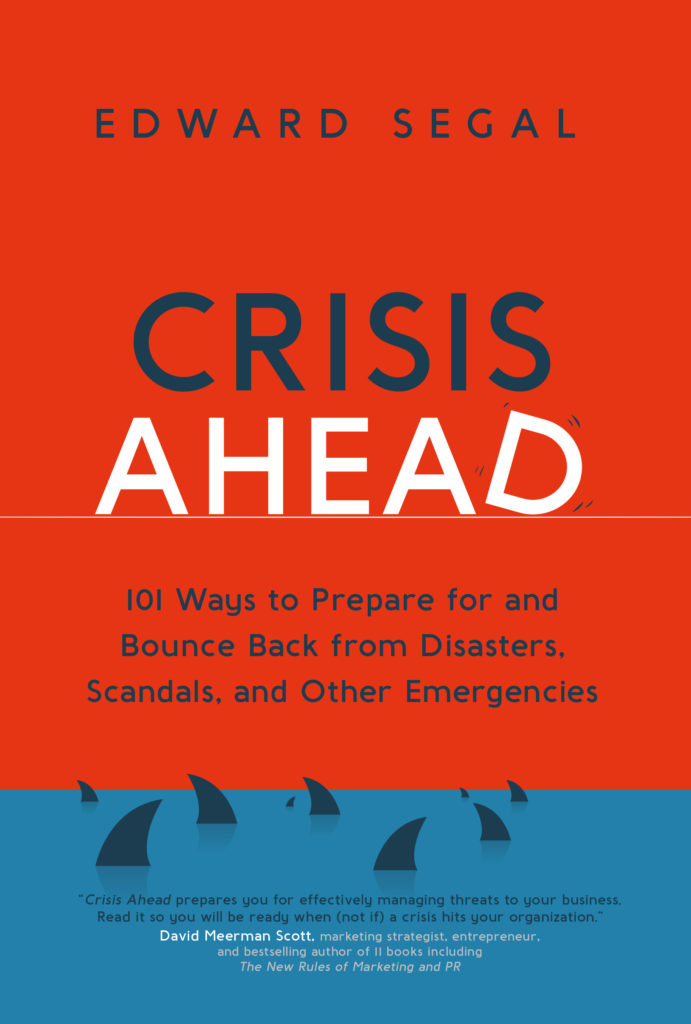Reviewed by Sharon Broughton (May 12, 2020)
Crisis Ahead: 101 Ways to Prepare for and Bounce Back from Disasters, Scandals, and Other Emergencies, Edward Segal, Nicholas Brealey, June 16, 2020, 256 pp., $25.95
From the perspective of a COVID-19 global pandemic-influenced world, this book landed on my desk with both a sense of urgency and a rueful, half-hearted apologetic smile.
“Never let a good crisis go to waste”. Uh-huh.
Scenario planning is a key component of crisis preparedness, and no less than 72 separate potential crises are offered in this very readable resource as samples for leaders to test themselves and their teams against. Notable in its absence among everything from fires to earthquakes, social media fails, fraud, child abuse, terrorism, racial profiling and ransomware is a global pandemic and its effects on local and global economies.
But in a way, this proves the point of the book, written pre-coronavirus. Recognizing that we cannot predict and prevent every crisis from occurring, Edward Segal urges leaders to understand that it is our preparedness to confront potential issues that is essential.
The more we’re ready, having tested ways to act, communicate and problem-solve, the more likely our survival across to the other side.”
Segal distils his more than 30 years experience as a crisis management, PR and media relations expert into practical advice with clear rationale for action. While his CV suggests he has ‘seen it all’, his approach is not to focus on what the right answers were to situations in the past, but rather to share, teach, unpack case studies and offer ways leaders and organizations can create the approaches best suited to their realities.
The definition of a crisis according to Segal is “any internal or external event that can impact the image, reputation, activity, bottom line, or future of an organization or disrupt or prevent normal operations.” For any of us who have lived through organizational crises without an explicit plan to guide decisions and actions, the “10 reasons why you need a crisis plan’’ chapter offers nine reasons more than you need.
Practicing with a draft plan is a strong recommendation – one that organizations like NASA, airports, and banks take seriously. Having a draft plan that can be tested and modified makes it effective and real. Lessons shared include always starting with the facts; having an identified crisis management team; considering how newsworthy your crisis can be; making sure everyone knows what to do when the media calls; keep communicating; leaders should be seen and heard; and never stop learning.
Packed with checklists, templates and tools, you can go directly to the resources and links to start building your own crisis plan or begin by reviewing the 102 crises ‘triggers’ to see how other organizations handled these by visiting the author’s website GetCrisisReady.com.
As an example of one of these trigger situations, Segal shares best practices for what to do in preventing and responding to the well-publicized crisis of two Boeing jetliners crashing within months of each other (suggesting that this one is a textbook case of how not to handle things). Recommendations specific to this scenario include being aggressive in identifying problems that can lead to a crisis; saying and doing something when you know something is wrong; not blaming others for your mistakes; saying you’re at fault if you are; and not delaying in apologizing.
This book would be a great tool to help leaders prevent, prepare for, respond to, manage and bounce back from a crisis. Consider it as a gift for your senior team, and workshop some of the ideas with your staff group. Review the cases, self-test with how many of the best practices you have confidence in for your own setting and create an action list for preparedness.”
Bouncing Back is the title of the final chapter – how to recover from a crisis. Examples are shared from the Bounce Back Hall of Fame, including individuals and organizations who have moved forward and reinvented themselves post-crisis from Martha Stewart to Kathy Griffin, Pepsi to Starbucks. Here in Canada we can think of others – McCain Foods post-listeriosis, for one.
As we begin the process to phase back from the sheltering in place era of the coronavirus pandemic, collectively creating the ‘new normal’, we may well be facing not just how to bounce back as non-profits within our local and national contexts, but our next capital C Crisis.
Crisis Ready would be an asset to any organization’s recovery strategy planning group, as leaders work through the ideal approach to face the next wave of uncertain times in our immediate future.
Leaders today will need to find additional innovative ways to build and test their plans, possibly creating virtual drills until the in-person variety are feasible. No doubt, examples we are experiencing and leading through right now will emerge as cases to consider in the next edition of this excellent resource.
Sharon Broughton, M.Ed. is the Chief Executive Officer of Prince’s Trust Canada, a national charity supporting young people facing barriers to employment and veterans in transition, as well as an Instructor in U of T’s Non-Profit Leadership for Impact certificate program.

